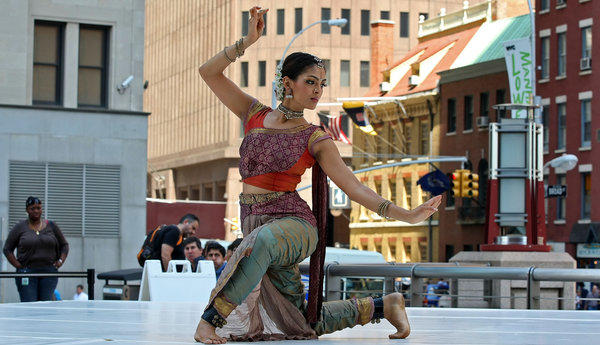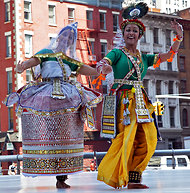
| Invitation |
| About the Festival |
| Performer Bios |
| Special Showcase |
| Workshops |
| Press Release |
| Reviews |
| Call for Submission |
| Downtown Dance Festival |
| Reviews |
| The New York Times - Aug. 18, 2011 Stopping Traffic Downtown With a Subcontinent's Movements ALASTAIR MACAULAY |
 |
| Erasing Borders Festival of Indian Dance: included a performance by Rukmini Vijayakumar, above, presented by the Indo-American Arts Council as part of the Downtown Dance Festival. |
Each August now brings one of the highlights of the New York dance calendar in, of all places, the Financial District at lunchtime: namely, the Erasing Borders Festival of Indian Dance open-air performance. It’s held as part of the Battery Dance Company’s annual Downtown Dance Festival and presented by the Indo-American Arts Council. What makes it marvelous isn't necessarily the quality of the dance (the event is an anthology of Indian styles) or the authenticity of its delivery (most of the music is taped and considerably amplified) but its sheer incongruity. You see people of various races stopping in their tracks to watch, or gazing down from their office windows, while dancers in traditional Indian costume perform dances from the other side of the world, against a backdrop of New York skyscrapers and a soundscape of urban noise. During Wednesday's performance at 1 New York Plaza a bus happened to pass by bearing an ad that said, "Incredible India." What makes it marvelous isn't necessarily the quality of the dance (the event is an anthology of Indian styles) or the authenticity of its delivery (most of the music is taped and considerably amplified) but its sheer incongruity. You see people of various races stopping in their tracks to watch, or gazing down from their office windows, while dancers in traditional Indian costume perform dances from the other side of the world, against a backdrop of New York skyscrapers and a soundscape of urban noise. During Wednesday's performance at 1 New York Plaza a bus happened to pass by bearing an ad that said, "Incredible India."The event's other great virtue is its diversity of styles, new and old, and deriving from different geographical regions. And since few of us in the West see a great deal of any Indian dance form, it all adds to our collective knowledge. It's fascinating to see not just how the old forms differ from one another but also to identify the many sensuous features they have in common. A program will include — several times over — dances that range from pure form to communicative gesticulation; footwork that employs the ball of the foot and heel as well as an excitingly slap of the sole; a wonderfully pliancy of the spine as well as a sharply geometrical sense of addressing contrasting bodily directions (right versus left, one diagonal versus another). Not to mention a precise choreography of the eyes; an articulation of the hands and fingers that is thrillingly elaborate by any Western standard; a powerful coordination of gesture, eye and torso; and a complex metrical sense far from any Western norm. Larger than all those details is the way that Indian dance connects the dancer to things beyond herself (or, more rarely, himself). The human addresses the divine, nature, abstract forces and the cosmos. Often a subtle but profound acting sense is involved, so that you see a dancer become multiple characters, and sometimes a single dancer conducting both sides of a dialogue. The sense of connection and empathy — indeed the sense of self — is complex, affecting, but, to a Western eye, disconcerting. Most Indian dancers take the stage in a vividly entertaining way, often with bright smiles and a keen sense of the audience; but what becomes more striking is their humility, of immersion in something that extends far beyond themselves. Wednesday's performance brought a strikingly lovely woman, Rukmini Vijayakumar, dancing both the Bharatanatyam idiom and a modern number. It also included examples of two unfamiliar but traditional genres, Mohiniattam (from Kerala in southwestern India) and — especially rare in New York — Manipuri (from the hills of northeastern India). The slender, supple Ms. Vijayakumar has a stirringly beautiful face, with burning eyes that repeatedly catch the observer's breath; and she makes those eyes part of the fabric of the dance. She uses the whole body, sometimes acrobatically. She is the first Bharatanatyam dancer I can remember to do the splits, and in her modern solo she takes one sculptural balance and then adjusts it to hold her foot, behind her, up by her head. But the glories of her dancing are primarily in her upper body: her lower-body rhythm is clear but soft in enunciation. In terms of gesture, switches of angle and communicating swift changes of emotion (alarm, then surprise, then joy), she is not just engaging but also authoritative. Nothing in the program, however, was more picturesque than the single-file entrance of the seven Manipuri dancers from the Natya Academy: six women followed a bare-chested and white-turbaned male drummer. His solo — the "Pung Cholam" — was quite an event. He danced while still drumming and sometimes held balances, hopped while holding a position and then even turned in that hopping position. His movements were all calmly and quietly achieved with more emphasis on length of phrase than percussive excitement. Meanwhile the six women each held a pair of tasseled cymbals: first the color of the tassels makes one effect, until the rhythm of the cymbals makes another. Earlier on, two female Manipuri dancers danced the "Yugal Nartan." The tall headdress of the first (playing Krishna), with its circular plumed decoration, and the rigid, bright farthingale worn by the second (as Radha) stay in the memory. Both combined pattering footwork beneath upper-body tilting. The Erasing Borders festival has not presented Manipuri in New York before; it would be good to see a whole program of it one day. Mandakini Trivedi opened Wednesday's performance with a solo in the Mohiniattam style of invocation to the elephant-headed god Ganapati. That evening I went to see her perform an entire program at the Anamika-Navatman Project in Midtown. She is a sharp-faced and intelligent dancer who charmingly shows you her idiom's swinging, swaying, undulating appeal. Her own dancing itself has no special beauties, but she makes you want to see more of Mohiniattam. Where she comes into her own is as an actress: at the beginning of each dance, her face alone has changed, and her body language has a number of lively mutations as she plays different characters. To hear in advance what "You and Me," a contemporary number danced by Lakshmi Sriraman and Aniruddhan Vasudevan, was about gave hopes of a profound study of lovers' exchanging identities. The choreography, however, proved a trite and dull affair, depending largely on the dancers intertwining each others' scarves. The same two dancers — with their dissimilar builds, they made an unlikely couple — were livelier in a Bharatanatyam duet, showing plenty of detail of gesture, footwork and positions. The program included no stylist of transcendent grace or virtuosity, but its spectrum of Indian possibilities did good service to the subcontinent it represented. The Downtown Dance Festival runs through Saturday at various locations in Lower Manhattan; (212) 219-3910, batterydance.org. |
| Source: http://www.nytimes.com/2011/08/19/arts/dance/erasing-borders-festival-of-indian-dance-review.html?_r=1 |